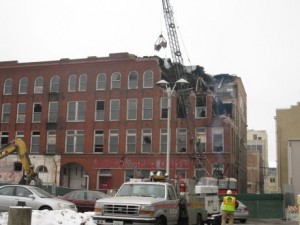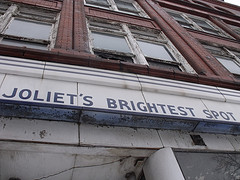Last week as I walked down Chicago Street in downtown Joliet on my way to work, a giant crane — the jaws of its bucket suspended high in the cold gray winter sky — began the demolition of The White Store.
Here in America, we’re good at a lot of things. One of them is knocking down buildings we consider to be worn out, old-fashioned, and/or irrelevant. Some of these structures were admittedly unremarkable in their architecture; others, though, were beautiful in design and possessed historical significance. One need only study the sorry history of lost buildings in Chicago to realize this.
The imminent razing of Joliet’s 102-year-old White Store signals an end to the occasionally controversial debate over its fate, but is also an apt moment to pause and reflect on what kind of building should take its place in Joliet Junior College’s downtown campus redevelopment.
Fortunately, JJC’s project is not an isolated endeavor, but part of their comprehensive master plan for the institution’s growth and evolution. Another factor is that the building design has not been finalized, to my knowledge.
Consequently, I offer the following humble suggestions to the project’s leaders, with the caveat that I am neither an architect nor an urban planner — merely an interested citizen.
(1) Go local. The Chicago region has a long and illustrious architectural history, and is exceedingly rich in design talent and building innovation. The downtown campus redevelopment could be a showcase project for a deserving firm, tie Joliet’s contemporary cityscape into that regional architectural legacy, and in the process feed the northeastern Illinois economy.
(2) Make it green. With its LEED-certified greenhouse as well as other campus sustainability initiatives, JJC is leaping to the forefront of environmentally progressive colleges and universities. Building a model green structure would further this momentum, and create an environmental destination in downtown Joliet (much like notable green buildings draw visitors and media to other cities).
 (3) Be bold. This building must be special — a visual statement possessing flair and integrity. It should be unique in character and well-fitted to its purpose, yet harmonize with the heterogeneous architectural landscape of downtown. The last thing the world needs is another functional yet blasé box of a building.
(3) Be bold. This building must be special — a visual statement possessing flair and integrity. It should be unique in character and well-fitted to its purpose, yet harmonize with the heterogeneous architectural landscape of downtown. The last thing the world needs is another functional yet blasé box of a building.
(4) Get lucky. The State’s financial house, unfortunately, is crumbling as fast as The White Store is, leaving JJC’s funding prospects uncertain. A miraculous economic turnaround in Illinois wouldn’t hurt, would it?
This article was published as “JJC’s Plan Should Be Bold, Green” in the Joliet Herald-News on Feb. 3rd, 2011. I write a monthly op-ed piece for the paper on local environmental, culture, and political issues. This is the same newspaper that I delivered as a kid, on foot and on my bike — including the days after the legendary Blizzard of ’79 that hit the Chicago region with a snowfall nearly equal to this week’s storm.
Professor Bryson, thank you for your commentary on the downtown Joliet site evolution. There is an opportunity for the world to witness a new beautiful architectural academic milestone! Congratulations to Joliet Junior College’s downtown campus redevelopment!
Thank you for your inspiring vision, Professor Bryson.
E English
Sr. RU College of Professional Studies